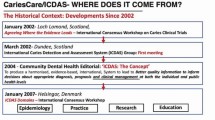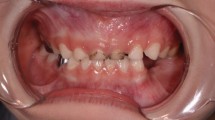Abstract
Background Dental caries in children's permanent teeth remains a global burden. In contrast to the traditional approach of treating the disease through surgical operative intervention, minimum intervention has increasingly been recommended for managing children with dental caries.
Aim This scoping review aimed to describe the literature related to the provision of minimum intervention dentistry for children with caries and to identify research gaps.
Methods Electronic databases (Medline via Ovid, PubMed, Web of Science and Scopus) were searched, together with grey literature databases, and key organisation websites. Data was extracted on a piloted extraction template and a thematic analysis was undertaken.
Results Sixty-seven relevant articles were identified. No empirical literature was identified that assessed a complete minimum intervention care pathway to managing caries. Five themes were identified from the scoping literature: evidence base, clinician attitude and skills, practice implementation, acceptability and environmental factors.
Conclusions The majority of articles were opinion papers. There is a paucity of empirical evidence supporting the clinical and cost-effectiveness of a minimum intervention pathway for children with dental caries in primary dental care. The scoping review has identified some potential barriers to the implementation of such a care pathway, including regulatory and remunerative frameworks and clinical training/education.
Key points
-
Describes the process of carrying out a scoping review of the literature on minimum intervention dentistry for children with dental caries.
-
Describes the literature on minimum intervention dentistry and children with dental caries.
-
Suggests further research is needed to explore the clinical and cost-effectiveness of a minimum intervention dentistry care pathway for children with dental caries.
This is a preview of subscription content, access via your institution
Access options
Subscribe to this journal
Receive 24 print issues and online access
$259.00 per year
only $10.79 per issue
Buy this article
- Purchase on Springer Link
- Instant access to full article PDF
Prices may be subject to local taxes which are calculated during checkout


Similar content being viewed by others
References
GBD 2017 Oral Disorders Collaborators, Bernabe E, Marcenes W et al. Global, Regional, and National Levels and Trends in Burden of Oral Conditions from 1990 to 2017: A Systematic Analysis for the Global Burden of Disease 2017 Study. J Dent Res 2020; 99: 362-373.
Pitts N, Chadwick B, Anderson T. Child Dental Health Survey 2013 Report 2: Dental Disease and Damage in Children England, Wales and Northern Ireland. 2015. Available at https://digital.nhs.uk/data-and-information/publications/statistical/children-s-dental-health-survey/child-dental-health-survey-2013-england-wales-and-northern-ireland (accessed April 2021).
Black G V. A work on operative dentistry. Chicago: Medical Dental Publishing, 1908.
Elderton R J. The prevalence of failure of restorations: a literature review. J Dent 1976; 4: 207-210.
Koulourides T, Feagin F, Pigman W. Remineralization of dental enamel by saliva in vitro. Ann N Y Acad Sci 1965; 131: 751-757.
Dawson A S, Makinson O F. Dental treatment and dental health. Part 1. A review of studies in support of a philosophy of Minimum Intervention Dentistry. Aust Dent J 1992; 37: 126-132.
Dawson A S, Makinson O F. Dental treatment and dental health. Part 2. An alternative philosophy and some new treatment modalities in operative dentistry. Aust Dent J 1992; 37: 205-210.
FDI World Dental Federation. FDI policy statement on Minimal Intervention Dentistry (MID) for managing dental caries: Adopted by the General Assembly: September 2016, Poznan, Poland. Int Dent J 2016; 67: 6-7.
Frencken J E, Peters M C, Manton D J, Leal S C, Gordan V V, Eden E. Minimal intervention dentistry for managing dental caries - a review: report of a FDI task group. Int Dent J 2017; 62: 223-243.
Tyas M J, Anusavice K J, Frencken J E, Mount G J. Minimal intervention dentistry-a review. FDI Commission Project 1-97. Int Dent J 2000;50: 1-12.
Craig P, Dieppe P, Macintyre S et al. Developing and evaluating complex interventions: the new Medical Research Council guidance. BMJ 2008; DOI: 10.1136/bmj.a1655.
Banerjee A. 'MI'opia or 20/20 vision? Br Dent J 2013; 214: 101-105.
Banerjee A. 'Minimum intervention' - MI inspiring future oral healthcare? Br Dent J 2017; 223: 133-135.
Calache H, Hopcraft M S, Martin J M. Minimum intervention dentistry - A new horizon in public oral health care. Aust Dent J 2013; 58 Suppl 1: 17-25.
Featherstone J D B, Doméjean S. Minimal intervention dentistry: Part 1. from 'compulsive' restorative dentistry to rational therapeutic strategies. Br Dent J 2012; 213: 441-445.
Innes N P, Manton D J. Minimum intervention children's dentistry - the starting point for a lifetime of oral health. Br Dent J 2017; 223: 205-213.
Arksey H, O'Malley L. Scoping studies: Towards a methodological framework. Int J Soc Res Methodol 2005; 8: 19-32.
Levac D, Colquhoun H, O'Brien K K. Scoping studies: advancing the methodology. Implement Sci 2010; 5: 69.
de Menezes Abreu D M, Leal S C, Mulder J, Frencken J E. Pain experience after conventional, atraumatic, and ultraconservative restorative treatments in 6-to 7-yr-old children. Eur J Oral Sci 2011; 119: 163-168.
Freitas M F L, Santos J M, Fuks A, Bezerra A C B, Azevedo T D P L. Minimal Intervention Dentistry Procedures: a Ten Year Retrospective Study. J Clin Pediatr Dent 2014; 39: 64-67.
Mandari G J, Frencken J E, van't Hof M A. Six-year success rates of occlusal amalgam and glass-ionomer restorations placed using three minimal intervention approaches. Caries Res 2003; 37: 246-253.
Mickenautsch S, Yengopal V. Extent and quality of systematic review evidence related to minimum intervention in dentistry: essential oils, powered toothbrushes, triclosan, xylitol. Int Dent J 2011; 61: 179-192.
Tyas M J, Anusavice K J, Frencken J E, Mount G J. Minimal intervention dentistry - a review - FDI Commission Project 1-97. Int Dent J 2000; 50: 1-12.
Mandari G J, Truin G J, van't Hof M A, Frencken J E. Effectiveness of three minimal intervention approaches for managing dental caries: survival of restorations after 2 years. Caries Res 2001; 35: 90-94.
Arrow P, Klobas E. Minimum intervention dentistry approach to managing early childhood caries: a randomized control trial. Community Dent Oral Epidemiol 2015; 43: 511-520.
Arrow P, Klobas E. Child oral health-related quality of life and early childhood caries: a non-inferiority randomized control trial. Aust Dent J 2016; 61: 227-235.
Arrow P, Klobas E. Minimal intervention dentistry for early childhood caries and child dental anxiety: a randomized controlled trial. Aust Dent J 2017; 62: 200-207.
Brennan D S, Balasubramanian M, Spencer A J. Restorative treatment for initial, cavitated and gross coronal carious lesions. Aust Dent J 2016; 61: 350-356.
Burke F J T, McHugh S, Shaw L et al. UK dentists' attitudes and behaviour towards Atraumatic Restorative Treatment for primary teeth. Br Dent J 2005; 199: 365-369.
Frencken J E. Atraumatic restorative treatment and minimal intervention dentistry. Br Dent J 2017; 223: 183-189.
Dawett B, Atkins B, Banerjee A. A guide to building 'MI' oral healthcare practice. Br Dent J 2017; 223: 223-227.
Doméjean S, Banerjee A, Featherstone J D B. Caries risk/susceptibility assessment: its value in minimum intervention oral healthcare. Br Dent J 2017; 223: 191-197.
Mickenautsch S. An introduction to minimum intervention dentistry. Singapore Dent J 2005; 27: 1-6.
Mickenautsch S, Rudolph M J. Minimal intervention dentistry (MI) for South Africa. SADJ 2004; 59: 327, 329.
Schwendicke F, Foster Page L A, Smith L A, Fontana M, Thomson W M, Baker S R. To fill or not to fill: a qualitative cross-country study on dentists' decisions in managing non-cavitated proximal caries lesions. Implement Sci 2018; 13: 54.
D'Cruz L. Dento-legal considerations about an MI approach. Br Dent J 2017; 223: 199-201.
Mackenzie L, Banerjee A. Minimally invasive direct restorations: a practical guide. Br Dent J 2017; 223: 163-171.
Craig P, Dieppe P, Macintyre S, Michie S, Nazareth I, Petticrew M. Developing and evaluating complex interventions: the new Medical Research Council guidance. Int J Nurs Stud 2013; 50: 587-592.
Craig P, Petticrew M. Developing and evaluating complex interventions: reflections on the 2008 MRC guidance. Int J Nurs Stud 2013; 50: 585-587.
Squires J E, Valentine J C, Grimshaw J M. Systematic reviews of complex interventions: framing the review question. J Clin Epidemiol 2013; 66: 1215-1222.
Brocklehurst P R, Williams L, Burton C, Goodwin T, Rycroft-Malone J. Implementation and trial evidence: a plea for fore-thought. Br Dent J 2017; 222: 331-335.
Marshman Z, Gibson B J, Owens J et al. Seen but not heard: a systematic review of the place of the child in 21st-century dental research. Int J Paediatr Dent 2007; 17: 320-327.
Banerjee A. Minimum intervention oral healthcare delivery - is there consensus? Br Dent J 2020; 229: 393-395.
Funding
The project was funded by the National Institute for Health Research (NIHR) through a Doctoral Research Fellowship. The views and opinions expressed by the authors in this publication are those of the authors and do not necessarily reflect those of the NIHR.
Author information
Authors and Affiliations
Contributions
BD, CD, AB, DP and ZM contributed towards the conception of the design. BD, DP and ZM contributed towards data aquistion and analysis. All authors contributed towards interpretation, drafted and critically revised the manuscript.
Corresponding author
Ethics declarations
None to disclose.
Supplementary Information
Rights and permissions
About this article
Cite this article
Dawett, B., Deery, C., Banerjee, A. et al. A scoping literature review on minimum intervention dentistry for children with dental caries. Br Dent J (2022). https://doi.org/10.1038/s41415-022-4038-8
Received:
Accepted:
Published:
DOI: https://doi.org/10.1038/s41415-022-4038-8



